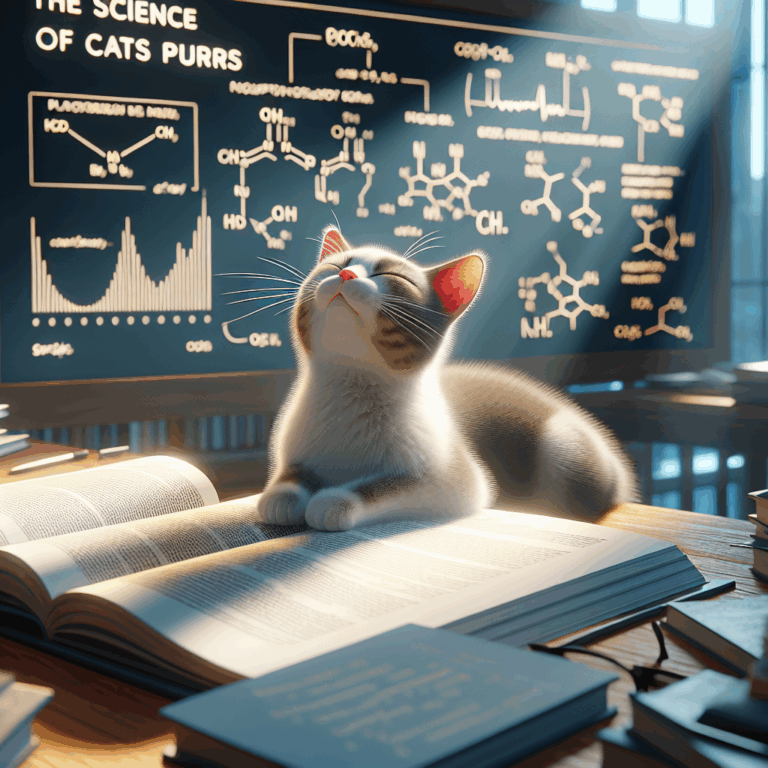The Science of Cat Purrs: Unveiling the Mystery Behind the Soothing Sound
- No Comments
In the realm of feline behavior, few phenomena are as universally adored and yet as enigmatic as the cat’s purr. This gentle, rhythmic sound, often associated with contentment and affection, has puzzled scientists and cat enthusiasts alike for decades. Recent studies, however, are beginning to shed light on the mechanics and potential purposes of purring, revealing that this simple sound might be more complex than previously thought.
The mechanics of purring have long been a subject of scientific inquiry. It is generally agreed that purring is produced by a repetitive neural oscillator in the cat’s brain. This sends messages to the laryngeal muscles, causing them to twitch at a rate of 25 to 150 vibrations per second (Hz). This twitching causes a sudden separation of the vocal cords during both inhalation and exhalation, producing a consistent sound that is distinctly different from a cat’s other vocalizations, such as meows or hisses.
While purring is most commonly associated with a cat’s contentment, it is not solely an expression of pleasure. Cats also purr when frightened, in pain, or even while giving birth. This has led researchers to propose that purring may serve a therapeutic role. A groundbreaking study at the University of Sussex discovered that the frequency of cat purrs, particularly between 25 and 50 Hz, promotes healing in bones and tissues. This frequency range is known to be beneficial in reducing pain and swelling and promoting the healing of fractures.
Moreover, purring may play an essential role in communication and social bonding within the cat community and with humans. Kittens are known to start purring at just a few days old while nursing, which is thought to be a signal to their mother that they are content and encourage continued care. In adult cats, purring can be a means of soliciting attention, food, or affection from their human companions.
The soothing effect of a cat’s purr is not limited to the feline itself. Many cat owners report feeling a sense of calm and relaxation when their pet purrs while sitting on their lap. This phenomenon, often referred to as the “purr therapy,” suggests that the vibrations from a purring cat may also have a calming effect on humans. In fact, studies have shown that the presence of a purring cat can reduce stress levels and lower blood pressure, potentially offering real health benefits to owners.
Despite these insights, many aspects of purring remain a mystery. Not all cats purr, and the reasons why some cats purr more than others continue to be a topic of speculation. Furthermore, while most domesticated cats have the ability to purr, big cats like lions and tigers do not. The evolutionary reasons for these differences are still unclear, prompting further research into the genetic and environmental factors that influence this fascinating behavior.
In conclusion, while the cat’s purr is a sound many of us take for granted, it is a complex and multifaceted behavior with implications that extend beyond simple contentment. As our understanding of purring deepens, so too does our appreciation for these enigmatic creatures who have shared their lives with humans for thousands of years. The science of cat purrs is a reminder of the intricate and often mysterious bond we share with our feline friends, a bond that continues to captivate and inspire curiosity across the globe.

In the realm of feline behavior, few phenomena are as universally adored and yet as enigmatic as the cat’s purr. This gentle, rhythmic sound, often associated with contentment and affection, has puzzled scientists and cat enthusiasts alike for decades. Recent studies, however, are beginning to shed light on the mechanics and potential purposes of purring, revealing that this simple sound might be more complex than previously thought.
The mechanics of purring have long been a subject of scientific inquiry. It is generally agreed that purring is produced by a repetitive neural oscillator in the cat’s brain. This sends messages to the laryngeal muscles, causing them to twitch at a rate of 25 to 150 vibrations per second (Hz). This twitching causes a sudden separation of the vocal cords during both inhalation and exhalation, producing a consistent sound that is distinctly different from a cat’s other vocalizations, such as meows or hisses.
While purring is most commonly associated with a cat’s contentment, it is not solely an expression of pleasure. Cats also purr when frightened, in pain, or even while giving birth. This has led researchers to propose that purring may serve a therapeutic role. A groundbreaking study at the University of Sussex discovered that the frequency of cat purrs, particularly between 25 and 50 Hz, promotes healing in bones and tissues. This frequency range is known to be beneficial in reducing pain and swelling and promoting the healing of fractures.
Moreover, purring may play an essential role in communication and social bonding within the cat community and with humans. Kittens are known to start purring at just a few days old while nursing, which is thought to be a signal to their mother that they are content and encourage continued care. In adult cats, purring can be a means of soliciting attention, food, or affection from their human companions.
The soothing effect of a cat’s purr is not limited to the feline itself. Many cat owners report feeling a sense of calm and relaxation when their pet purrs while sitting on their lap. This phenomenon, often referred to as the “purr therapy,” suggests that the vibrations from a purring cat may also have a calming effect on humans. In fact, studies have shown that the presence of a purring cat can reduce stress levels and lower blood pressure, potentially offering real health benefits to owners.
Despite these insights, many aspects of purring remain a mystery. Not all cats purr, and the reasons why some cats purr more than others continue to be a topic of speculation. Furthermore, while most domesticated cats have the ability to purr, big cats like lions and tigers do not. The evolutionary reasons for these differences are still unclear, prompting further research into the genetic and environmental factors that influence this fascinating behavior.
In conclusion, while the cat’s purr is a sound many of us take for granted, it is a complex and multifaceted behavior with implications that extend beyond simple contentment. As our understanding of purring deepens, so too does our appreciation for these enigmatic creatures who have shared their lives with humans for thousands of years. The science of cat purrs is a reminder of the intricate and often mysterious bond we share with our feline friends, a bond that continues to captivate and inspire curiosity across the globe.


